Influence of Carbon Source on the Buffer Layer for 4H-SiC Homoepitaxial Growth
Abstract
:1. Introduction
2. Materials and Methods
3. Results
3.1. Effect of C/Si on the Buffer Layer
3.2. Effect of Pre-Carbonization on the Buffer Layer
3.3. Effect of Buffer Layer C/Si on Epitaxial Layer
3.4. Effect of H2 Etching Time on Epitaxial Layer
3.5. Effect of Growth Pressure on Epitaxial Layer
4. Conclusions
Author Contributions
Funding
Institutional Review Board Statement
Informed Consent Statement
Data Availability Statement
Conflicts of Interest
References
- Li, K.; Sun, P.; He, Z.; Wu, S.; Luo, Q.; Du, X. A Deep Insight Into the Impact of Bipolar Degradations on Avalanche Robustness of 4H-SiC MOSFETs. IEEE Trans. Electron Devices 2023, 70, 3726–3734. [Google Scholar] [CrossRef]
- Chaudhuri, S.K.; Nag, R.; Ahmad, I.; Mandal, K.C. Alpha Particle Detection Using Highly Rectifying Ni/Ga2O3/4H-SiC Heteroepitaxial MOS Junction. IEEE Trans. Electron Devices 2023, 70, 6439–6445. [Google Scholar] [CrossRef]
- Lew, C.T.-K.; Sewani, V.K.; Ohshima, T.; McCallum, J.C.; Johnson, B.C. Charge Pumping Electrically Detected Magnetic Resonance of Silicon Carbide Power Transistors. J. Appl. Phys. 2023, 134, 055703. [Google Scholar] [CrossRef]
- Khosa, R.Y.; Chen, J.T.; Winters, M.; Pálsson, K.; Karhu, R.; Hassan, J.; Rorsman, N.; Sveinbjӧrnsson, E.Ö. Electrical Characterization of High K-Dielectrics for 4H-SiC MIS Devices. Mater. Sci. Semicond. Process. 2019, 98, 55–58. [Google Scholar] [CrossRef]
- Deng, X.; Huang, W.; Li, X.; Li, X.; Chen, C.; Wen, Y.; Ding, J.; Chen, W.; Sun, Y.; Zhang, B. Investigation of Failure Mechanisms of 1200 V Rated Trench SiC MOSFETs Under Repetitive Avalanche Stress. IEEE Trans. Power Electron. 2022, 37, 10562–10571. [Google Scholar] [CrossRef]
- Wei, J.; Wei, Z.; Fu, H.; Cao, J.; Wu, T.; Sun, J.; Zhu, X.; Li, S.; Zhang, L.; Liu, S.; et al. Review on the Reliability Mechanisms of SiC Power MOSFETs: A Comparison Between Planar-Gate and Trench-Gate Structures. IEEE Trans. Power Electron. 2023, 38, 8990–9005. [Google Scholar] [CrossRef]
- Yazdanfar, M.; Danielsson, Ö.; Kordina, O.; Janzén, E.; Pedersen, H. Finding the Optimum Chloride-Based Chemistry for Chemical Vapor Deposition of SiC. ECS J. Solid State Sci. Technol. 2014, 3, P320–P323. [Google Scholar] [CrossRef]
- Goue, O.Y.; Raghothamachar, B.; Yang, Y.; Guo, J.; Dudley, M.; Kisslinger, K.; Trunek, A.J.; Neudeck, P.G.; Spry, D.J.; Woodworth, A.A. Study of Defect Structures in 6H-SiC a/m-Plane Pseudofiber Crystals Grown by Hot-Wall CVD Epitaxy. J. Electron. Mater. 2016, 45, 2078–2086. [Google Scholar] [CrossRef]
- Li, J.; Yang, G.; Liu, X.; Luo, H.; Xu, L.; Zhang, Y.; Cui, C.; Pi, X.; Yang, D.; Wang, R. Dislocations in 4H Silicon Carbide. J. Phys. D Appl. Phys. 2022, 55, 463001. [Google Scholar] [CrossRef]
- Hu, J.; Jia, R.; Xin, B.; Peng, B.; Wang, Y.; Zhang, Y. Effect of Low Pressure on Surface Roughness and Morphological Defects of 4H-SiC Epitaxial Layers. Materials 2016, 9, 743. [Google Scholar] [CrossRef]
- Ji, S.; Kojima, K.; Ishida, Y.; Yoshida, S.; Tsuchida, H.; Okumura, H. Suppression of Al Memory-Effect on Growing 4H-SiC Epilayers by Hot-Wall Chemical Vapor Deposition. Jpn. J. Appl. Phys. 2013, 52, 04CP04. [Google Scholar] [CrossRef]
- Ding, W.; Lu, P.; Xu, Q.; Zhang, C.; Tu, R.; Zhang, S. Grain Size and Grain Boundary Characteristics on the Out-Plane Thermal Conductivity of <111>-Oriented CVD 3C–SiC. Ceram. Int. 2024, 50, 23775–23783. [Google Scholar] [CrossRef]
- Lu, P.; Huang, W.; Wang, J.; Yang, H.; Guo, S.; Li, B.; Wang, T.; Zhang, C.; Tu, R.; Zhang, S. High-Throughput Thermodynamic Study of SiC High-Temperature Chemical Vapor Deposition from TMS-H2. J. Cryst. Growth 2024, 626, 127489. [Google Scholar] [CrossRef]
- Wang, R.; Huang, Y.; Yang, D.; Pi, X. Impurities and Defects in 4H Silicon Carbide. Appl. Phys. Lett. 2023, 122, 180501. [Google Scholar] [CrossRef]
- Hu, J.; Jia, R.; Niu, Y.; Zang, Y.; Pu, H. Study of a New Type Nominal “Washboard-like” Triangular Defects in 4H-SiC 4° off-Axis (0 0 0 1) Si-Face Homoepitaxial Layers. J. Cryst. Growth 2019, 506, 14–18. [Google Scholar] [CrossRef]
- Sudarshan, T.S.; Rana, T.; Song, H.; Chandrashekhar, M.V.S. Trade-Off between Parasitic Deposition and SiC Homoepitaxial Growth Rate Using Halogenated Si-Precursors. ECS J. Solid State Sci. Technol. 2013, 2, 3079. [Google Scholar] [CrossRef]
- Tsuchida, H.; Ito, M.; Kamata, I.; Nagano, M. Formation of Extended Defects in 4H-SiC Epitaxial Growth and Development of a Fast Growth Technique. Phys. Status Solidi (b) 2009, 246, 1553–1568. [Google Scholar] [CrossRef]
- Pedersen, H.; Leone, S.; Henry, A.; Lundskog, A.; Janzén, E. Growth Characteristics of Chloride-based SiC Epitaxial Growth. Phys. Rapid Res. LTRS 2008, 2, 278–280. [Google Scholar] [CrossRef]
- Tang, Z.; Gu, L.; Ma, H.; Mao, C.; Wu, S.; Zhang, N.; Huang, J.; Fan, J. Influence of Temperature and Flow Ratio on the Morphology and Uniformity of 4H-SiC Epitaxial Layers Growth on 150 Mm 4° Off-Axis Substrates. Crystals 2022, 13, 62. [Google Scholar] [CrossRef]
- Tang, Z.; Gu, L.; Jin, L.; Dai, K.; Mao, C.; Wu, S.; Zhang, R.; Yang, J.; Ying, J.; Fan, J.; et al. Insights into the Effect of Susceptor Rotational Speed in CVD Reactor on the Quality of 4H-SiC Epitaxial Layer on Homogeneous Substrates. Mater. Today Commun. 2024, 38, 108037. [Google Scholar] [CrossRef]
- Yazdanfar, M.; Danielsson, Ö.; Kalered, E.; Sukkaew, P.; Kordina, O.; Nilsson, D.; Ivanov, I.G.; Ojamäe, L.; Janzén, E.; Pedersen, H. Brominated Chemistry for Chemical Vapor Deposition of Electronic Grade SiC. Chem. Mater. 2015, 27, 793–801. [Google Scholar] [CrossRef]
- Yang, S.; Zhao, S.; Chen, J.; Yan, G.; Shen, Z.; Zhao, W.; Wang, L.; Zhang, Y.; Liu, X.; Sun, G.; et al. Growth of 4H-SiC Epitaxial Layers at Temperatures below 1500 °C Using Trichlorosilane (TCS). J. Cryst. Growth 2023, 612, 127058. [Google Scholar] [CrossRef]
- Ul Hassan, J.; Karhu, R.; Lilja, L.; Janzén, E. Wafer Scale On-Axis Homoepitaxial Growth of 4H-SiC(0001) for High-Power Devices: Influence of Different Gas Phase Chemistries and Growth Rate Limitations. Cryst. Growth Des. 2019, 19, 3288–3297. [Google Scholar] [CrossRef]
- Kojima, K.; Okumura, H.; Kuroda, S.; Arai, K. Homoepitaxial Growth of 4H-SiC on on-Axis C-Face Substrates by Chemical Vapor Depositon. J. Cryst. Growth 2004, 269, 367–376. [Google Scholar] [CrossRef]
- Kim, H.; Lee, H.; Kim, Y.S.; Lee, S.; Kang, H.; Heo, J.; Kim, H.J. On-Axis Si-Face 4H-SiC Epitaxial Growth with Enhanced Polytype Stability by Controlling Micro-Steps during the H2 Etching Process. CrystEngComm 2017, 19, 2359–2366. [Google Scholar] [CrossRef]
- Shen, Z.; Zhang, F.; Liu, X.; Sun, G.; Zeng, Y. Influence of H2 Treatment on the Surface Morphology of SiC with Different Wafer Orientation and Doping. J. Cryst. Growth 2023, 607, 127105. [Google Scholar] [CrossRef]
- Chen, X.; Ai, W.; Zhao, H.; Li, Y.; Feng, J. Dynamic Behavior of Clusters in the Early Stage of SiC (0001) Epitaxial Growth: A Kinetic Monte Carlo Study. Vacuum 2021, 188, 110189. [Google Scholar] [CrossRef]
- Karhu, R.; Sveinbjörnsson, E.Ö.; Magnusson, B.; Ivanov, I.G.; Danielsson, Ö.; Ul Hassan, J. CVD Growth and Properties of On-Axis Vanadium Doped Semi-Insulating 4H-SiC Epilayers. J. Appl. Phys. 2019, 125, 045702. [Google Scholar] [CrossRef]
- Barcellona, M.; Badalà, P.; Boscaglia, M.; Cantiano, M.; Mello, D.; Ferlito, E.; Pirnaci, M.D.; Tenaglia, D.; Fragalà, M.E. Image Analysis Development for Optimization of 4H–SiC Trench Recovery Treatment by Combination of Gas Etching and Sacrificial Oxidation Approaches. Mater. Sci. Semicond. Process. 2024, 174, 108216. [Google Scholar] [CrossRef]
- Dong, L.; Sun, G.; Yu, J.; Zheng, L.; Liu, X.; Zhang, F.; Yan, G.; Li, X.; Wang, Z. Growth of 4H-SiC Epilayers with Low Surface Roughness and Morphological Defects Density on 4° off-Axis Substrates. Appl. Surf. Sci. 2013, 270, 301–306. [Google Scholar] [CrossRef]
- Nakamura, S.; Kimoto, T.; Matsunami, H. Rate-Determining Process in Chemical Vapor Deposition of SiC on off-Axis α-SiC (0 0 0 1). J. Cryst. Growth 2004, 270, 455–461. [Google Scholar] [CrossRef]
- Mochizuki, K.; Mishima, T. Evaluation of Critical Supersaturation Ratios during Epitaxial Growth of Hexagonal SiC {0001} under Carbon- and Hydrogen-Rich Conditions. Jpn. J. Appl. Phys. 2023, 62, 128003. [Google Scholar] [CrossRef]
- Mochizuki, K.; Mishima, T. Estimation of Supersaturation at Steps during Chemical Vapor Deposition of 4H-SiC (0001−) from Reported Growth Rate and Cross-Sectional Profile of Spiral Hillock. Jpn. J. Appl. Phys. 2022, 61, 118002. [Google Scholar] [CrossRef]
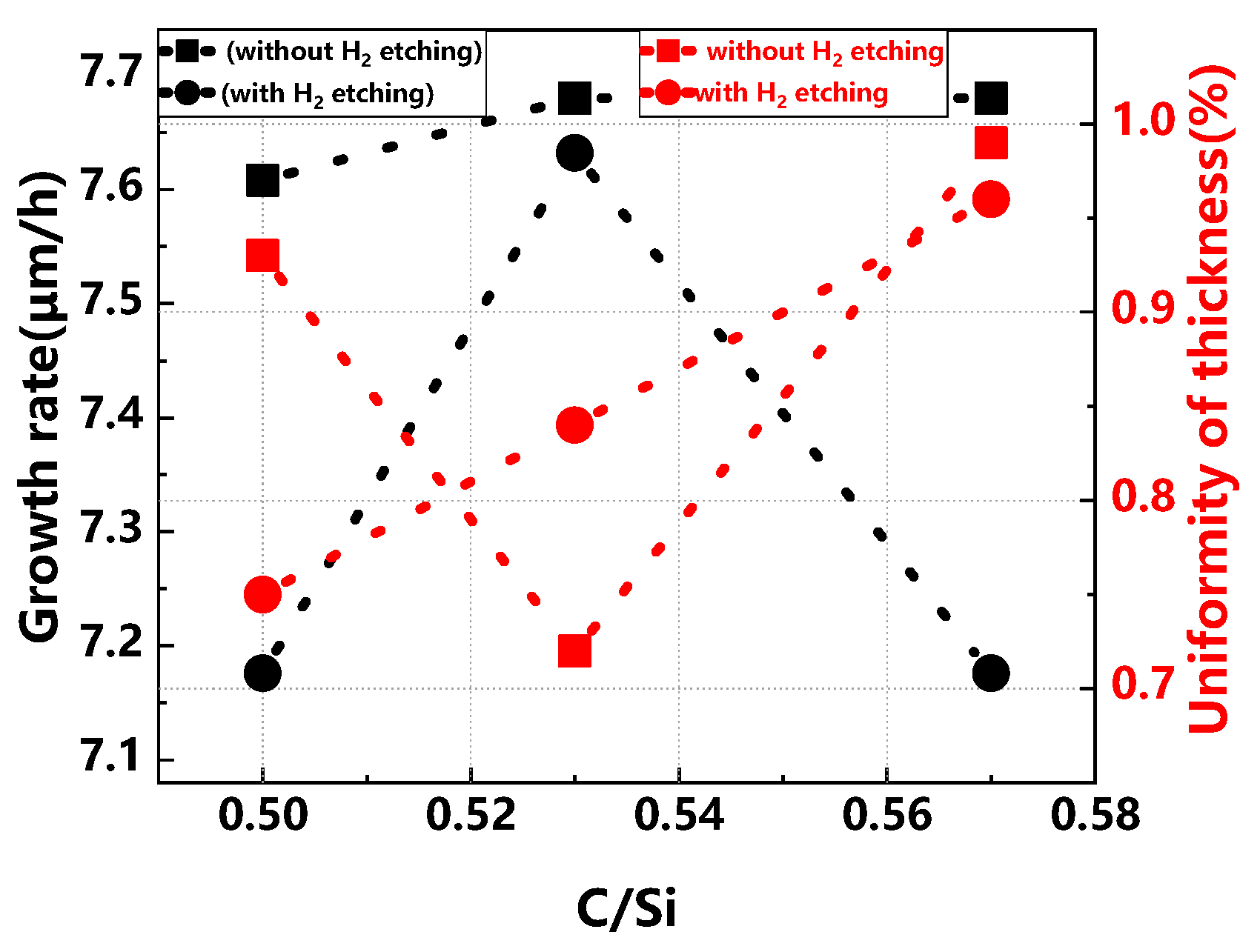

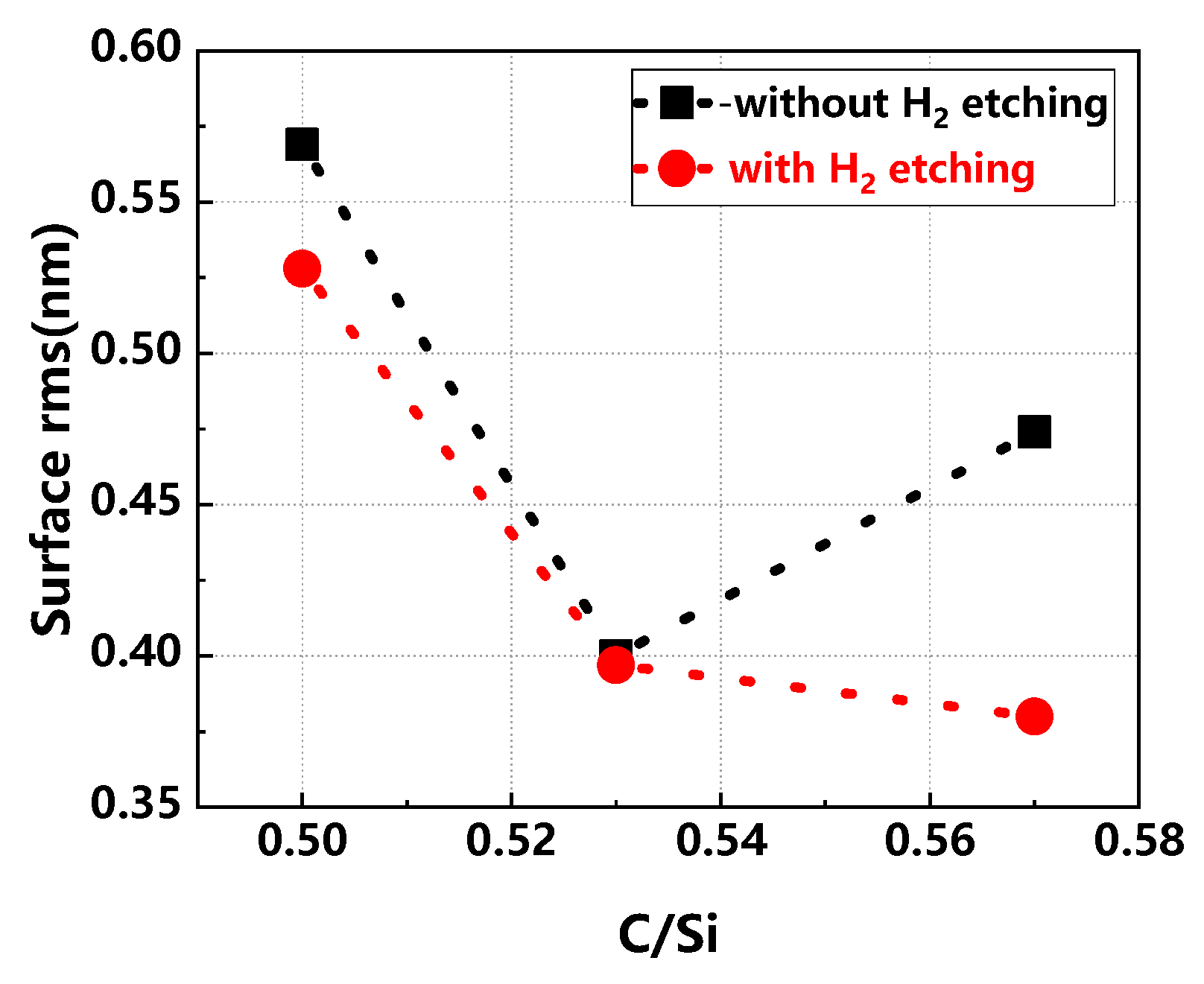
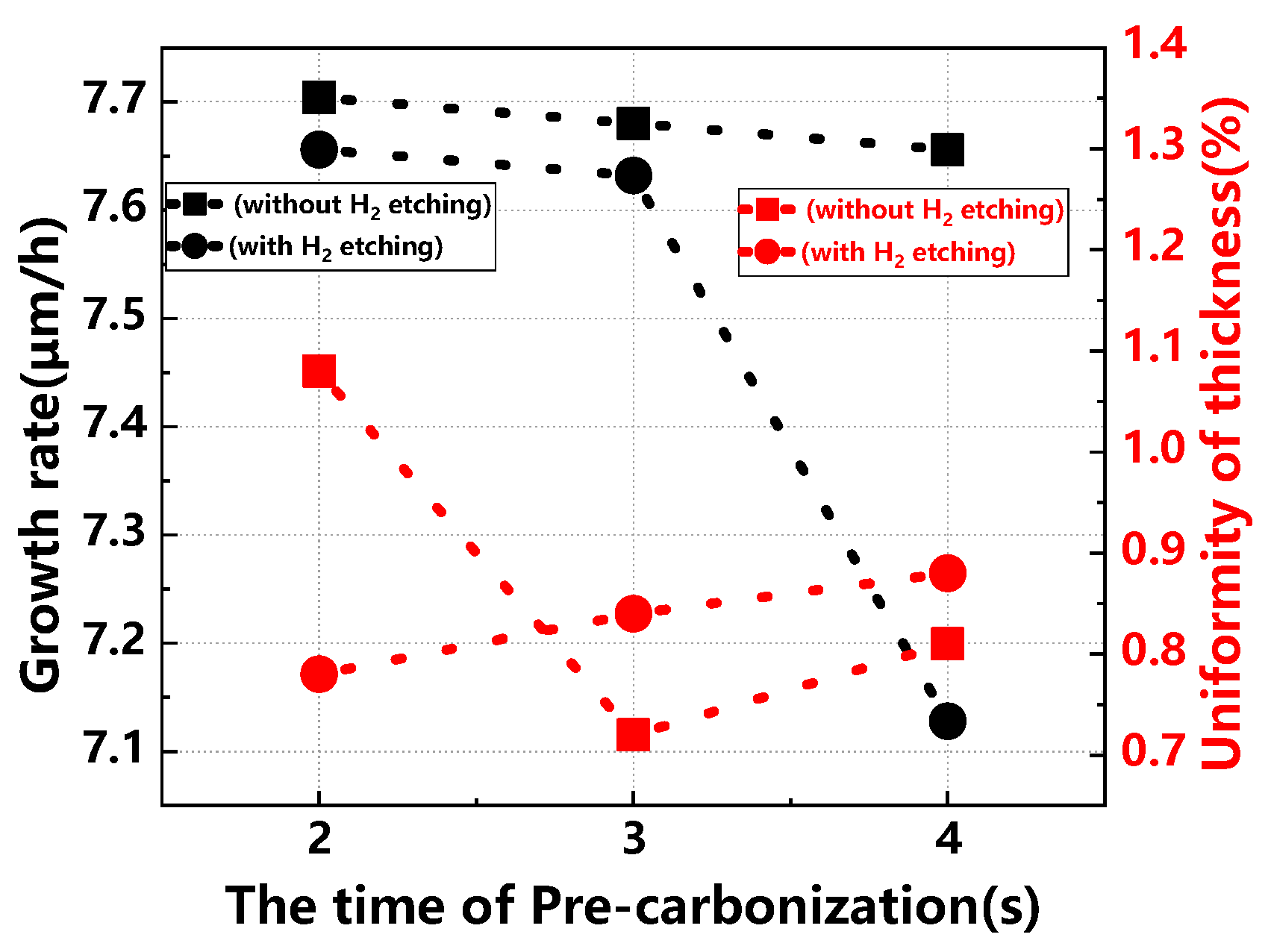
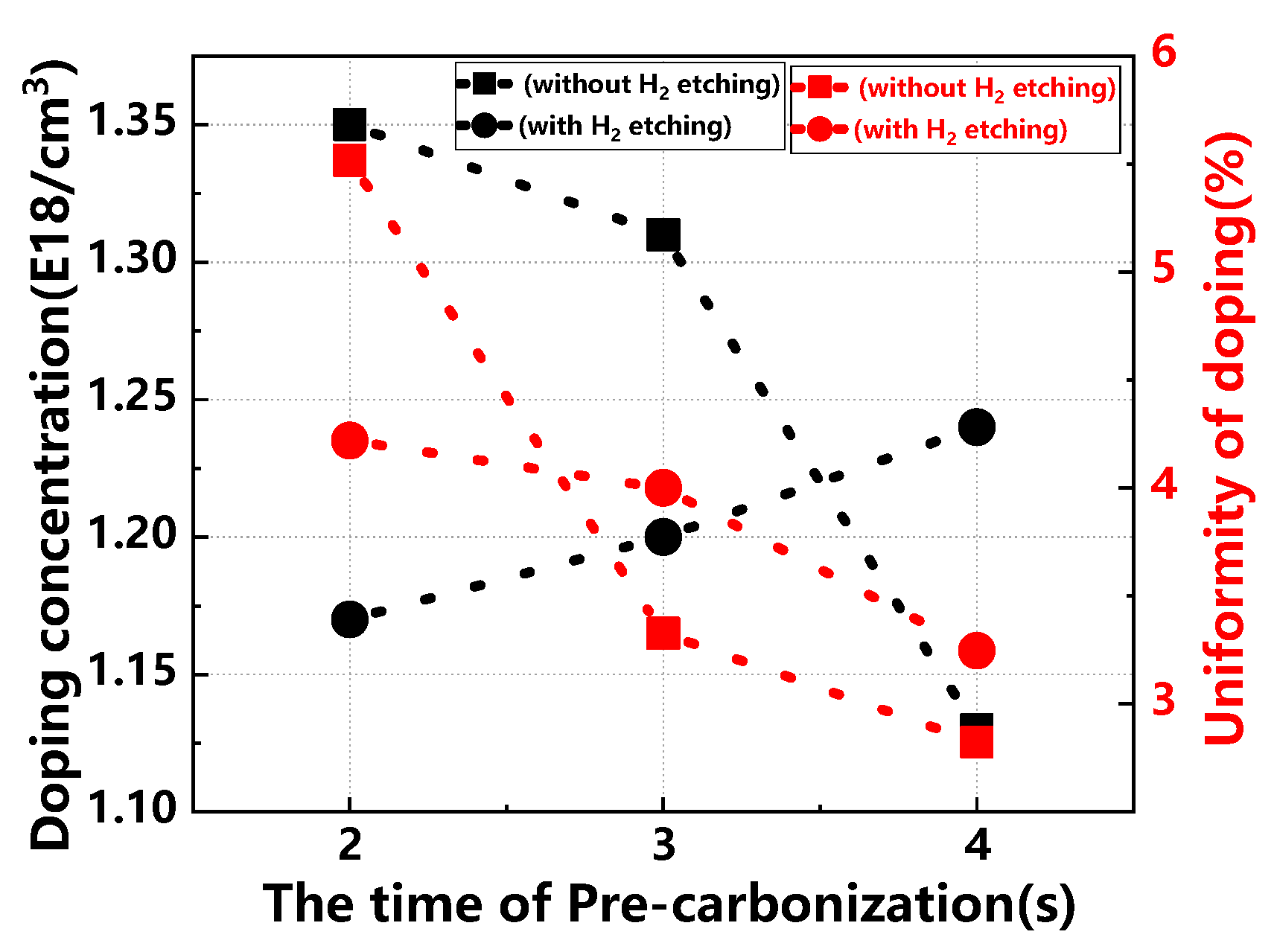
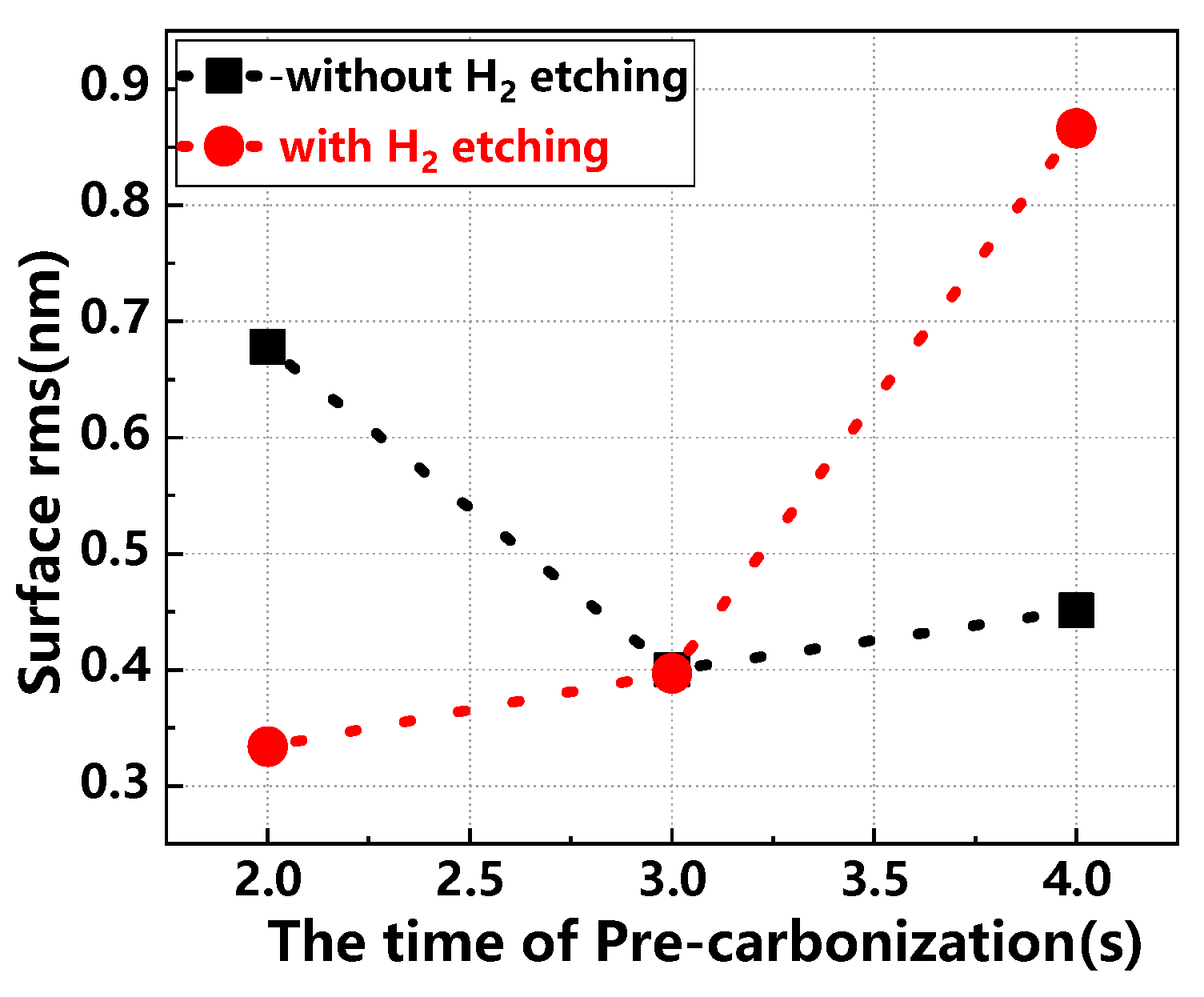

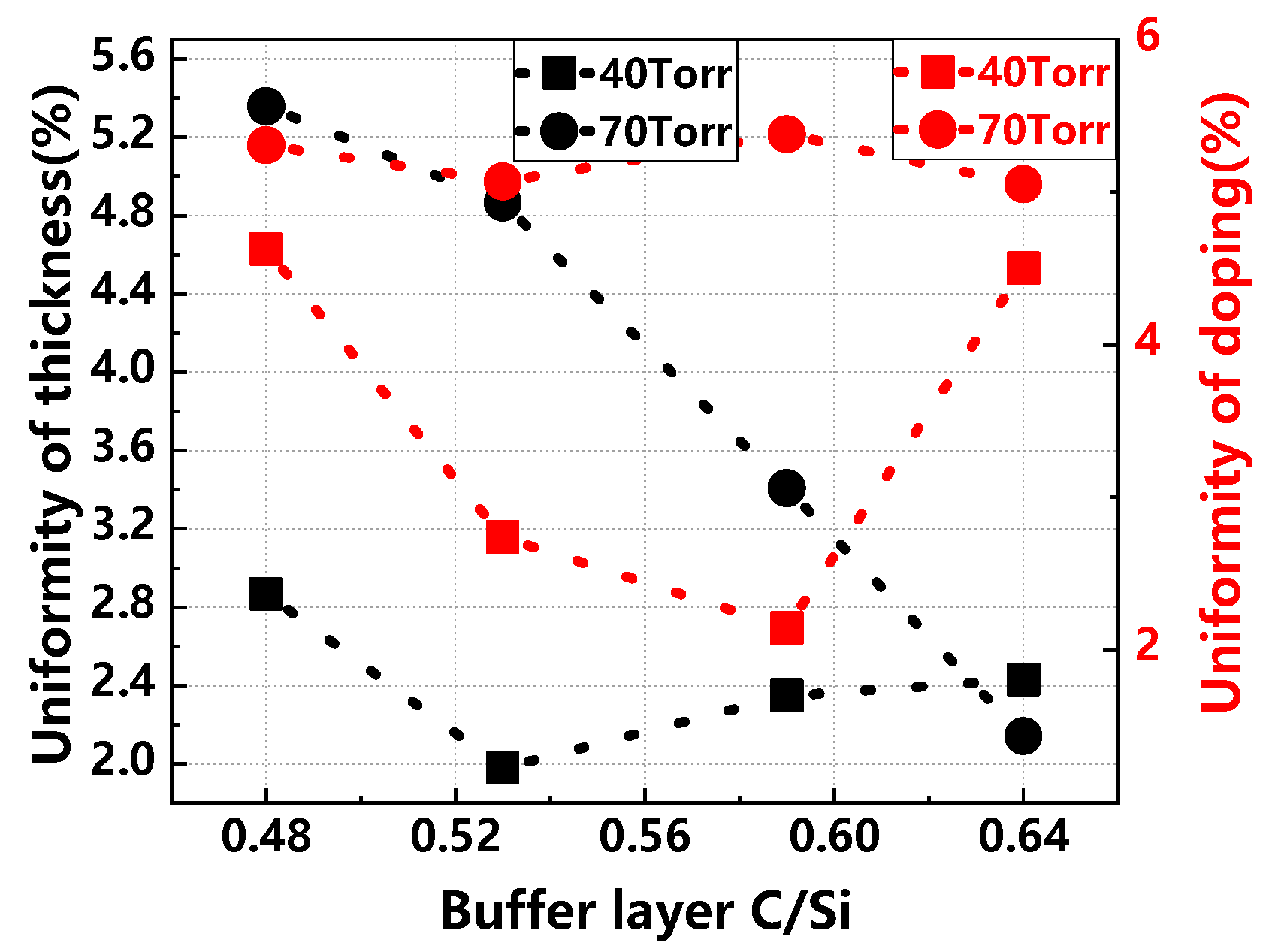

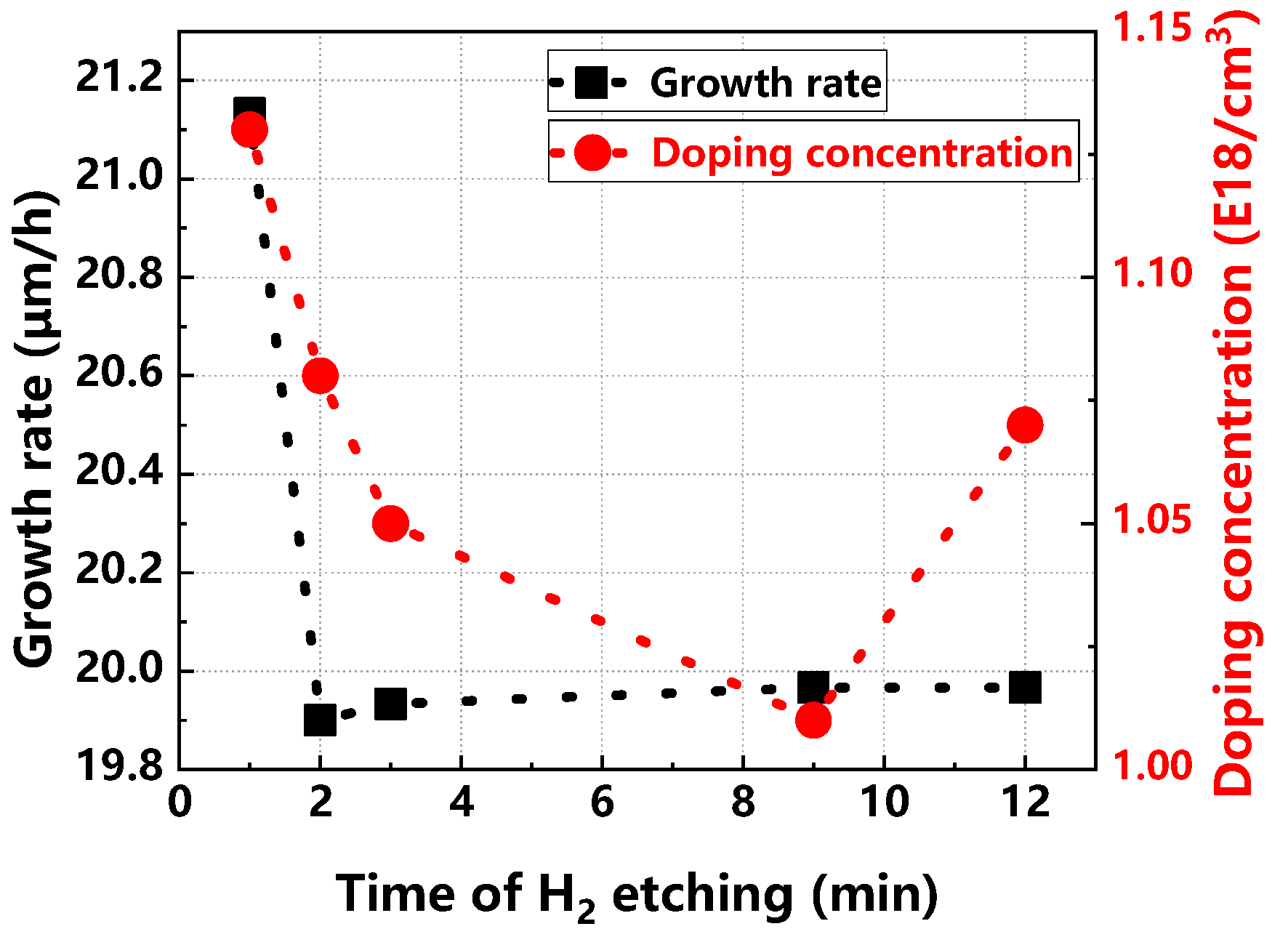



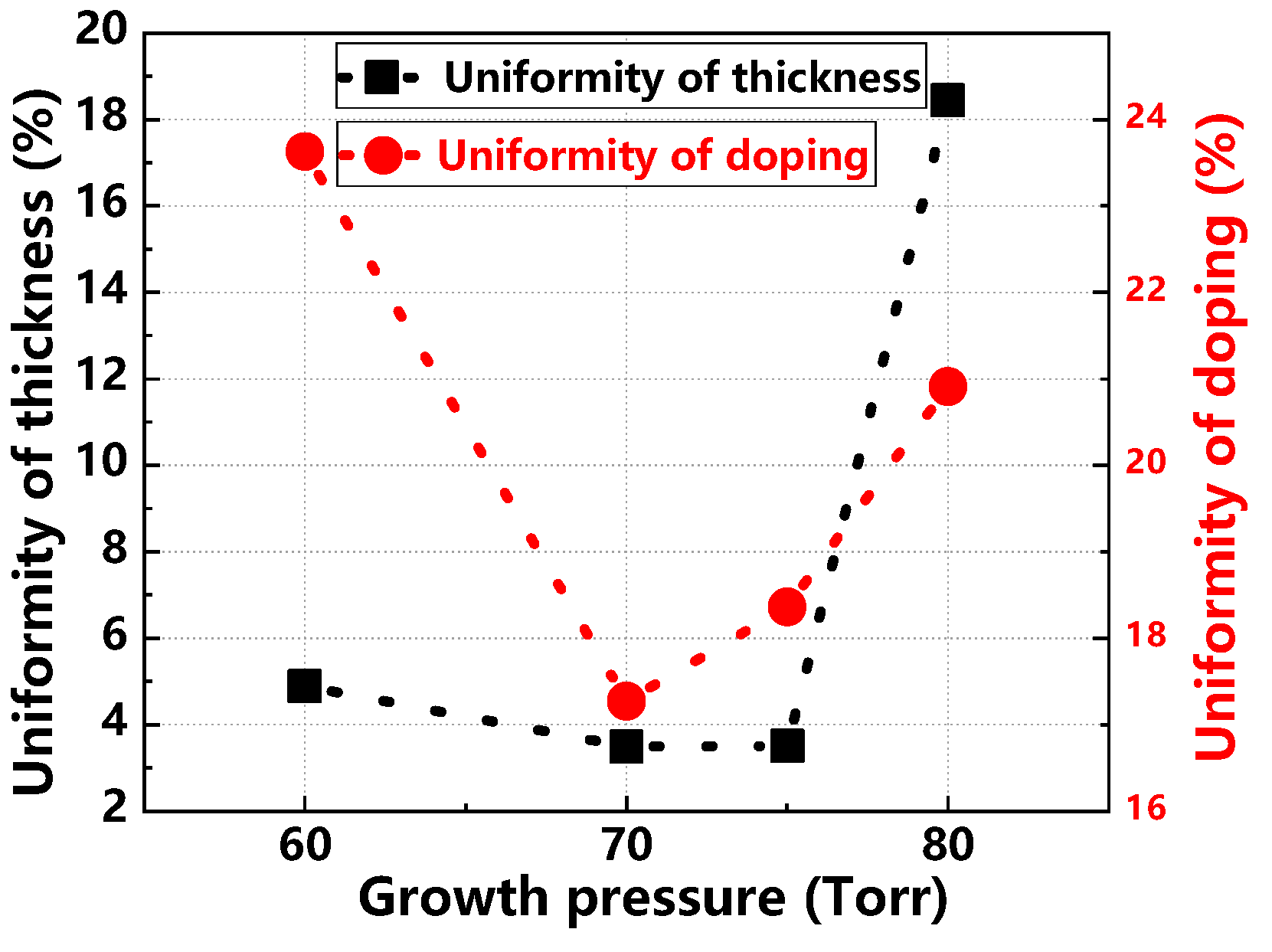
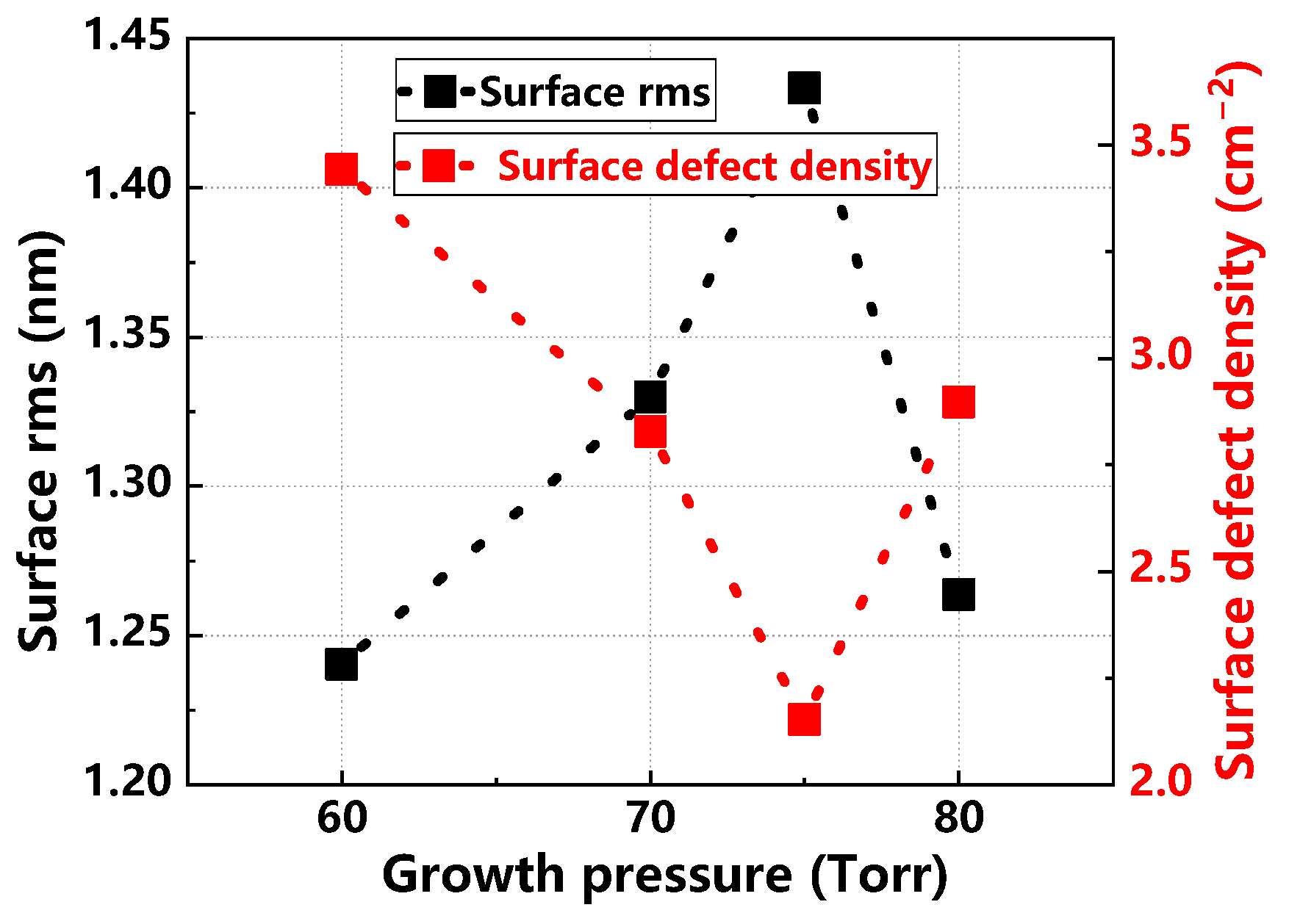
Disclaimer/Publisher’s Note: The statements, opinions and data contained in all publications are solely those of the individual author(s) and contributor(s) and not of MDPI and/or the editor(s). MDPI and/or the editor(s) disclaim responsibility for any injury to people or property resulting from any ideas, methods, instructions or products referred to in the content. |
© 2024 by the authors. Licensee MDPI, Basel, Switzerland. This article is an open access article distributed under the terms and conditions of the Creative Commons Attribution (CC BY) license (https://creativecommons.org/licenses/by/4.0/).
Share and Cite
Yang, S.; Guo, N.; Zhao, S.; Li, Y.; Wei, M.; Zhang, Y.; Liu, X. Influence of Carbon Source on the Buffer Layer for 4H-SiC Homoepitaxial Growth. Materials 2024, 17, 2612. https://doi.org/10.3390/ma17112612
Yang S, Guo N, Zhao S, Li Y, Wei M, Zhang Y, Liu X. Influence of Carbon Source on the Buffer Layer for 4H-SiC Homoepitaxial Growth. Materials. 2024; 17(11):2612. https://doi.org/10.3390/ma17112612
Chicago/Turabian StyleYang, Shangyu, Ning Guo, Siqi Zhao, Yunkai Li, Moyu Wei, Yang Zhang, and Xingfang Liu. 2024. "Influence of Carbon Source on the Buffer Layer for 4H-SiC Homoepitaxial Growth" Materials 17, no. 11: 2612. https://doi.org/10.3390/ma17112612





